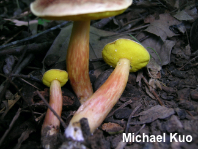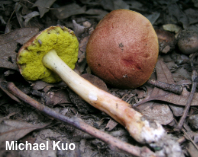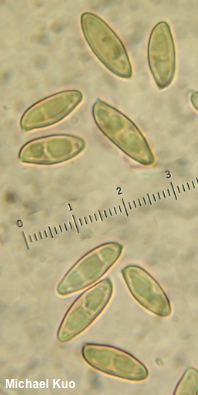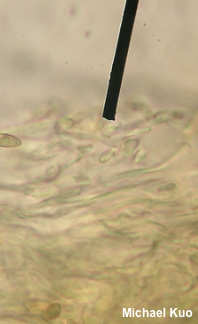| Major Groups > Boletes > Aureoboletus auriporus |

|
Aureoboletus auriporus [ Basidiomycota > Boletales > Boletaceae > Aureoboletus . . . ] by Michael Kuo Found in eastern North America's oak forests, this beautiful mushroom has a pinkish brown cap and an attention-grabbing, bright yellow pore surface that does not bruise, but may develop reddish spots with old age. When fresh the cap of Aureoboletus auriporus is sticky, and the basal mycelium at the bottom of the stem is white. Under the microscope, it features spores 11–16 µm long. Similar species include Aureoboletus viridiflavus, which is virtually identical but for its olive brown cap—and Boletus innixus, which features yellow basal mycelium and shorter spores (measuring 8–12 µm long), along with a tendency to grow in small clusters and a stem that is often swollen near the base, just before it tapers into a short "root." Boletus auriporus is a former name. Description: Ecology: Mycorrhizal with oaks and possibly other hardwoods; growing alone, scattered, or gregariously; summer and fall; widely distributed in eastern North America, through Texas into Mexico, Central America, and South America. The illustrated and described collections are from Illinois. Cap: 1.5–5 cm; convex, becoming broadly convex; tacky to sticky when fresh; bald or, when young, very finely velvety; pinkish brown to reddish brown or brown, sometimes with a mottled appearance; the margin with or without a tiny overhanging, sterile portion. Pore Surface: Bright yellow, becoming dull yellow; not bruising, but sometimes developing pinkish to reddish spots with age; 1–2 pores per mm at maturity; tubes olive yellow, to 8 mm deep. Stem: 4–7 cm long; 5–8 mm thick; slender; tapering to apex; bald; sticky when fresh; yellowish near apex; elsewhere streaky reddish and yellowish, becoming brownish; when young sometimes covered with fine yellow flocculence; not reticulate; basal mycelium white. Flesh: White to pale yellow; not changing on exposure. Odor and Taste: Odor not distinctive; taste of sticky cap surface acidic and sour (like putting your tongue on a radio battery); taste of flesh not distinctive. Chemical Reactions: Ammonia negative, green, or gray on cap; negative or bluish on flesh. KOH negative to orangish on cap; negative to yellowish on flesh. Iron salts negative to gray on cap; negative to gray on flesh; dark green to bluish on tubes. Spore Print: Olive. Microscopic Features: Spores 11–16 x 4–5.5 µm; ellipsoid to subfusoid; smooth; yellowish in KOH. Hymenial cystidia 30–65 x 7.5–12.5 µm; fusiform or lageniform; smooth; thin-walled; hyaline in KOH. Pileipellis a partially gelatinized cutis; elements 2.5–5 µm wide, smooth, hyaline to golden in KOH, sometimes poorly defined; terminal cells cylindric with rounded apices. REFERENCES: (Peck, 1872) Pouzar, 1957. (Coker & Beers, 1943; Singer, 1947; Snell & Dick, 1970; Smith & Thiers, 1971; Smith, Smith & Weber, 1981; Phillips, 1991/2005; Both, 1993; Bessette, Roody & Bessette, 2000; Roody, 2003; Binion et al., 2008; Klofac, 2010; Kuo & Methven, 2014; Bessette, Roody & Bessette, 2016; Baroni, 2017; Woehrel & Light, 2017; García-Jiménez et al., 2019; Zhang et al., 2019.) Herb. Kuo 07130401, 08200601, 06290704. This site contains no information about the edibility or toxicity of mushrooms. |
© MushroomExpert.Com |
|
Cite this page as: Kuo, M. (2020, January). Aureoboletus auriporus. Retrieved from the MushroomExpert.Com Web site: http://www.mushroomexpert.com/aureoboletus_auriporus.html |



